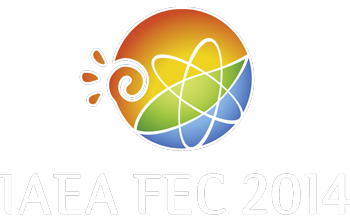Speaker
Dr
Motoki Nakata
(Japan Atomic Energy Agency)
Description
First-principle based gyrokinetic simulation is a powerful method for investigating turbulent transport in fusion plasmas. Since a local limit condition [(plasma size)/(ion gyroradius) >> 300] is well satisfied in ITER and DEMO reactors, quantitative evaluations for the prediction capability of local gyrokinetic simulations are crucially urgent and important issues.
This paper presents the first and brand-new results on the first-principle based turbulence simulation study on JT-60U tokamak plasmas [cf. (plasma size)/(ion gyroradius) ~ 500 for L-mode] by using a multi-species electromagnetic gyrokinetic code GKV with realistic MHD equilibria, towards ITER and DEMO. The inclusion of fully gyrokinetic ions and electrons beyond the conventional adiabatic approximation reveals a transition of dominant micro-instability from ITGs (inner core region) to TEMs (outer core region) depending on radial positions, and the resultant turbulent heat and particle transport levels are examined quantitatively.
New findings in this study are summarized below. (i)GKV simulations successfully reproduce experimental results on ITG/TEM driven ion and electron heat transport in the core region. Possible physical mechanisms on the so-called “transport shortfall” in the outer core region are examined in view of zonal flow dynamics. Also, (ii)different nonlinear dependence of ion-scale zonal flows on the heat and particle transport levels is newly identified, i.e., weaker impact on the electron heat and particle transport compared to the ion heat one.
These findings on the quantitative agreement among turbulence simulations and experimental results, and on the nonlinear dependence on zonal flows in the transport levels contribute significant progress in improving the prediction capability of gyrokinetic simulations and in constructing a more credible transport model for ITER and DEMO.
| Country or International Organisation | Japan |
|---|---|
| Paper Number | TH/P7-38 |
Author
Dr
Motoki Nakata
(Japan Atomic Energy Agency)
Co-authors
Dr
Hajime Urano
(JAEA)
Dr
Maiko Yoshida
(Japan Atomic Energy Agency)
Dr
Masanori Nunami
(National Institute for Fusion Science)
Dr
Mitsuru Honda
(Japan Atomic Energy Agency)
Dr
Shinya Maeyama
(Japan Atomic Energy Agency)
Dr
Tomohiko Watanabe
(Nagoya University)

